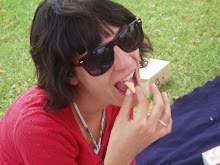I was a little bit nervous to make the dough, I’m not 100% sure why, maybe it was because eggs were involved. But after many many many minutes of shaping and working the flour and eggs together, I ended up with a nice soft ball of dough. Then after many more minutes of kneading, it became as smooth as a baby’s bottom, which is just how the cookbook said it should be. I wonder if this is what my great-grandmother – who was born in Pisa - would have spent hours doing in her kitchen.
Using the pasta machine was pretty simple, especially following the fantastically detailed sketches in Marcella Hazan’s The Essentials of Classic Italian Cooking. I’ve been told she’s the guru of Italian home cooking, so I felt confident having her by my side. Her book showed me exactly how to feed through the portions of dough to come out with long rectangular sheets. After about an hour of drying them on tea towels (I don’t think I actually needed to wait that long), they went through the cutting rollers for fettuccine. It was such a joy to watch the long, thin strands magically emerge from the machine.
Equally pleasurable was making the sauces. Still following Marcella’s instructions, I made a classic tomato sauce with onion and butter. Super easy. All you do is cut a teeny cross at the base of the tomatoes, plunge them into boiling water for about 1 minute then cool them a little before taking off the skin. After that, just chop them up then cook them with butter and onion for 45 minutes. And in the pan sits a deliciously sweet, rich tomato sauce - no canned peeled tomatoes required. The other sauce was mushrooms cooked with shallot, ham, cream and, yep, more butter. In the words of my dinner guest - "a cracker".
I had so much fun this week. While making the pasta took me a little longer than expected, it was totally satisfying. Set aside a good few hours if you plan on doing it - have fun. x

















